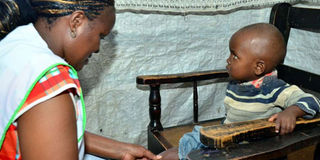New guidelines to help volunteers boost healthcare

A Community Health Worker examines a two-year-old in Korogocho Slums, Nairobi. Community workers can plug the shortage of health workers in Kenya. PHOTO| FILE
Kenya is among countries in the world where community health workers are being used to promote primary healthcare, but the World Health Organisation recommends more training for them to effectively execute their mandate.
WHO says that more focus is needed in disease prevention, health promotion and rehabilitation and recommends pre-service training curriculum for community health workers (CHWs) to promote of family planning, immunisation and HIV prevention.
In a new guideline, the WHO calls for improved clinical, diagnostic and curative services to achieve standardised primary healthcare.
Using simplified integrated management of childhood illness guidelines to classify and treat malaria, pneumonia and diarrhoea/dehydration concurrently, and use of flow sheets are among the measures WHO wants Kenya to take.
Kenya falls below the World Health Organisation’s recommendation of 23 doctors, nurses and mid-wives per 10,000 population, a situation that has led to an increased disease burden for the country.
The situation calls for innovative approaches towards bridging the gap.
The guidelines are intended to be used as a tool in the design, implementation, performance evaluation of effective community health worker programmes.
They contain practical recommendations on selection, training and certification; management and supervision: and integration into health systems and community engagement.
“By fully harnessing the potential of community health workers, including by dramatically improving their working and living conditions, we can make progress towards universal health coverage and achieving the health targets of the Sustainable Development Goals,” says Dr Tedros Adhanom Ghebreyesus, Director-General of WHO.
Strong primary healthcare systems, based in local communities, are essential for better health out-comes.
APPROACH
CHWs have been called the “world’s most promising health workforce resource” in terms of enabling health systems in resource-constrained settings.
Most often, CHWs—also referred to as community health volunteers (CHVs)—are relied upon to deliver a range of health services directly to communities and link households with the formal health system.
Recently, there has been resurgence in global attention to CHVs, recognising them as an integral part of the health workforce needed to achieve country health commitments.
A primary health care approach was first put forward 40 years ago in the Declaration of Alma-Ata.
Four decades later, the Declaration holds iconic status for having advocated not only for technical changes in the way health services are delivered, but also a fundamental change in the approach to health and well-being, linking them to social and economic development.
In 1978, the Declaration of Alma-Ata recognised community health workers as part of a diverse, sustainable team that responds effectively to the health needs of communities.
Forty years on, in Astana, the global health community gathered to affirm and reinvigorate its commitment to primary healthcare as fundamental to ensuring that everyone everywhere is able to enjoy the highest possible attainable standard of health.
The guidelines use evidence to identify effective policy options to strengthen CHW programme performance through proper integration in health systems and communities.
CRITICAL ANALYSIS
The development of these guidelines followed the standardised WHO approach. This entailed a critical analysis of the available evidence, including 16 systematic reviews of the evidence, a stakeholder perception survey to assess feasibility and acceptability of the policy options under consideration.
Also, the deliberations of a Guideline Development Group which comprised representation from policy makers and planners from member states, experts, labour unions, professional associations and CHWs took part in making the guidelines.
“Today, instead of health for all, we have health for some. We all have a solemn responsibility to ensure that today’s declaration on primary healthcare enables every person, everywhere to exercise their fundamental right to health,” said Dr Tedros during the conference.
While the 1978 Declaration of Alma-Ata laid a foundation for primary healthcare, progress over the past four decades has been uneven.
At least half the world’s population lacks access to essential health services – including care for non-communicable and communicable diseases, maternal and child health, mental health, and sexual and reproductive health.
“Although the world is a healthier place for children today than ever before, close to six million children die every year before their fifth birthday mostly from preventable causes, and more than 150 million are stunted,” said Henrietta Fore, UNICEF Executive Director.
He added, “We as a global community can change that, by bringing quality health services close to those who need them. That’s what primary healthcare is about.”



